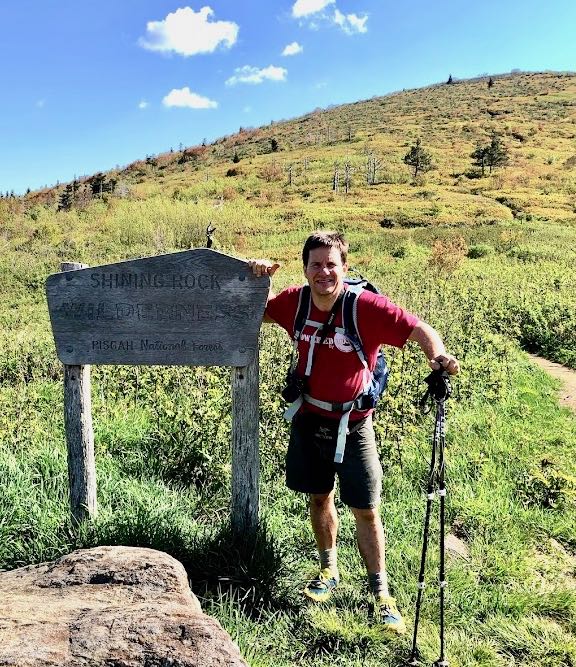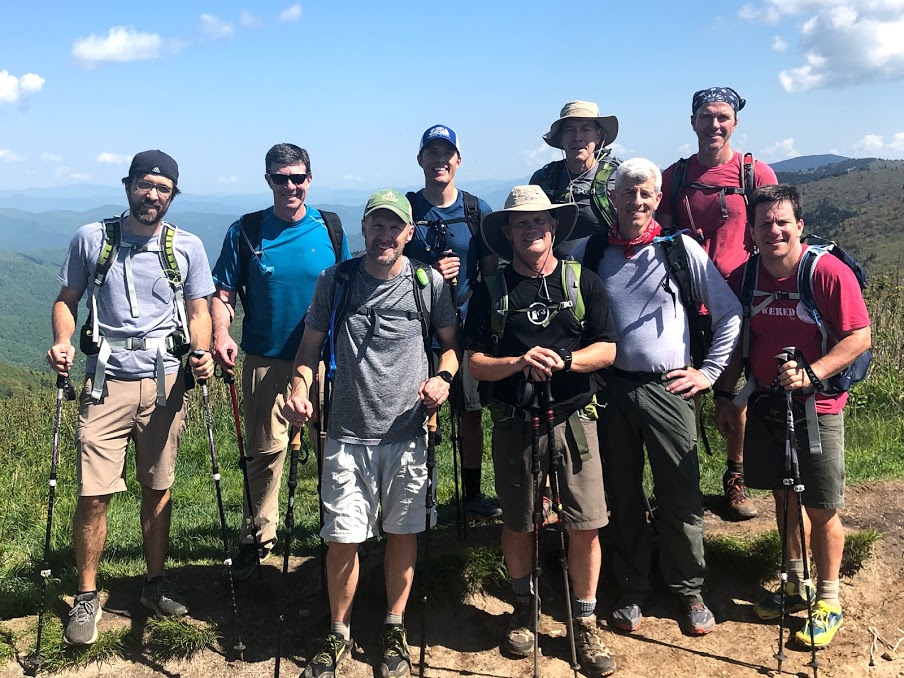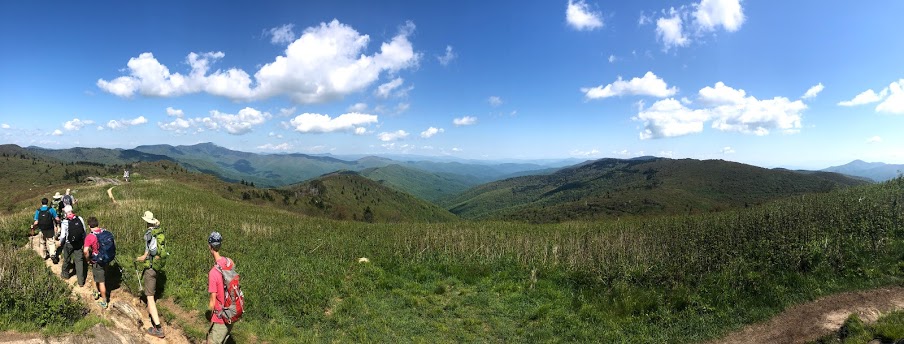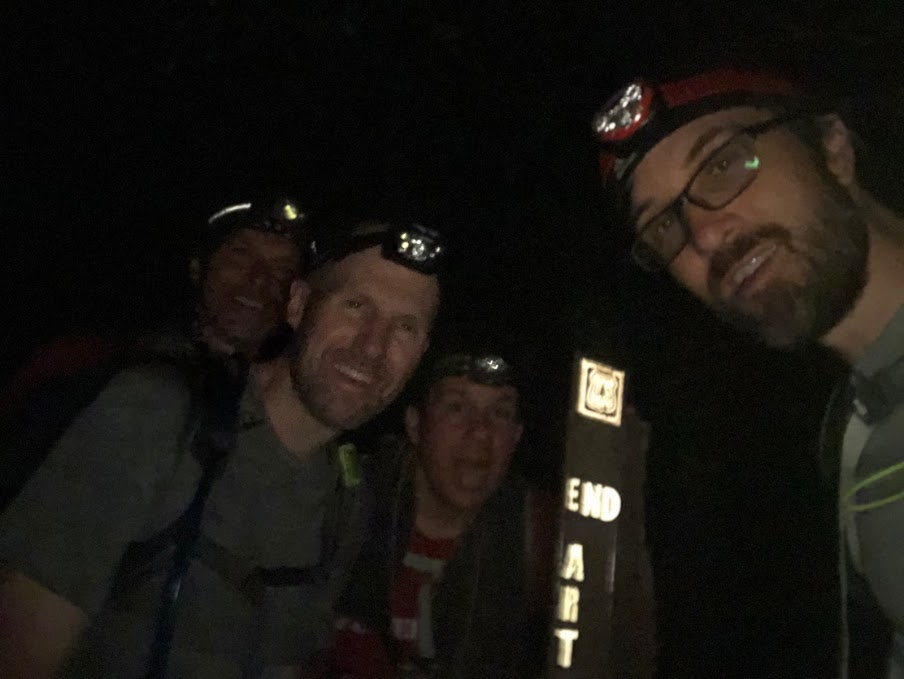
When Rudy Hayden, manager of our Charlotte shop, isn’t camping/climbing/hiking or otherwise exploring with his family, he likes to go for a day hike with the guys. In May, for instance, just shy of his 43rd birthday, he took nine of his F3 (Fitness, Fellowship and Faith; learn more about F3 Nation here) buddies for a hike on the Art Loeb Trail in the Pisgah National Forest. And not just on one of the Art Loeb’s many challenging stretches, but on the entire trail, starting in the dark at 5:30 a.m. from the north end at the Daniel Boone Scout Camp and finishing in the dark around 9:30 p.m., 30.1 miles and more then 8,200 feet of elevation later at the Davidson River Campground outside Brevard.
It’s rollercoaster of a hike that most people do as a three-day, two-night backpack trip. Doing it in a day — a 16-hour day — is a good way to test your physical and mental strength. It’s also a good way to test your gear.
So what kind of gear stands up to a 16-hour day on the Art Loeb Trail — deemed by National Geographic as one of the nation’s top 30 trails? Let’s start from the ground up.
Socks
“Lately,” says Rudy, “I’ve really been digging the Darn Tough socks. They’re padded where they need to be padded, and while they’re ribbed, they aren’t constricting. You know how some socks you can’t wait to take them off at the end of the day? Not these.” Rudy was also packing the Farm to Feet Damascus hiking socks: “That’s been my go-to hiking sock.”
Number of pairs of socks used on the Art Loeb? Three. “I changed socks when we stopped for water and to resupply. New socks are always so refreshing. They improve your morale!”

Shoes
Altra Lone Peak 4.0. Although it’s technically a trail running shoe, the Altra Lone Peak has emerged as the hiking shoe for thru-hikers, from the Appalachian Trail to the Pacific Crest Trail. How does such a lightweight shoe work for backpacking, a sport that not long ago was dominated by heavy leather boots? Some believe it’s because of the move toward ultralight backpacking. But because he’s frequently a trip leader, Rudy’s pack typically weighs around 35 pounds, more when he’s backpacking with the family. Rudy says the Altra line is well-suited to handle the load. “They have enough support laterally to provide the support I need. They also have a plate in the sole to protect your foot from rocks and roots.” They’re lightweight, too, he adds, weighing in at just 10.2 ounces.
Foot care
Rudy didn’t have any foot troubles on the hike — thanks to his socks and shoes — but several members of his expedition developed hot spots. “I had some eNZees Foot Soothers and they really did the trick.” eNZees are relatively new: it’s New Zealand lamb’s wool that’s combed into a soft, fluffy fleece that can be applied to prevent blisters and hot spots.
Shorts
“Some guys wore pants, I wore shorts, the Kuhl Renegades,” says Rudy. The Renegade is made of a durable soft-shell fabric called Duralux that feels like cotton but is stronger and more breathable, and is abrasion resistant, the latter coming in handy on tight passage through the heath balds between Investor Gap and Big Balsam on the Art Loeb. Plus, they dry pretty fast. Is that why Rudy prefers the Kuhl Renegades? “Nah. I like ‘em because they’re so comfortable.” As for drying out, Rudy says the real key to drying out gear on the trail isn’t necessarily the fabric, it’s speed. “Some pants dry quicker than others, but the real key to getting some thing to dry fast is to keep moving, to exert yourself.”

Shirt
A good shirt is pivotal on a hike, especially on a long one. It needs to be comfortable, and it needs to dry quickly: Even on a somewhat warm day in the high country a wet shirt that stays wet can send a chill. “I really like the blended stuff,” says Rudy, “and my favorite right now is the Free Fly Bamboo Lightweight Drifter Tee. “It’s a mix of bamboo and spandex. Since bamboo is a natural fiber, it it’s light, breathable, and comfortable.”
Day pack
Rudy likes both the Osprey Raptor 10 and the Osprey Stratos 24. Because of the extra gear he carried for this trip as leader — first-aid kit, extra clothes, water filter — he opted for the Stratos 24. “It’s well ventilated and super comfortable,” says Rudy. Plus, the harness system and hip belt accommodate more weight — about 14 pounds for Rudy on this trip — without him feeling the extra weight. “It handled my 100-ounce bladder and I had a Smartwater bottle full of Skratch electrolytes that was in one of the side pockets.”
Water filter
On a long hike you’ll likely need to filter water, and on this hike Rudy’s group filtered twice, using his Sawyer Mini. Rudy says he’s been using it a long time and, “I’m pretty happy with it.”
Trekking poles
“I couldn’t have finished the hike without my Leki hiking poles,” says Rudy. In fact, it’s the first bit of gear he mentioned, his trip MVP. Leki has been making poles for 60 years, and for reliability they’re tough to beat. They’re also a vital friend on the trail, lending a hand up climbs, saving your knees on descents, helping you stay upright on stream crossings.
So what’s next for Rudy and his gear? In October, he’s leading an F3 group on a three-day, 25-mile loop in Linville Gorge, a route dubbed, facetiously, “Is that all ya got?”
“Some of the guys wanted to do it as a day hike,” says Rudy. “But we’ll do it as a backpack trip.”
Besides, it’ll give Rudy a chance to test some camping gear.

